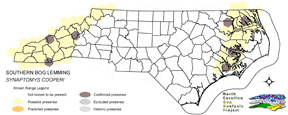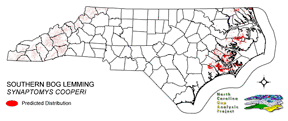
| Taxa: |
| Order: |
| Family: |
| Mammalia |
| Rodentia |
| Muridae |
| NatureServe Global Rank: |
| NatureServe State (NC) Rank: |
| G5 |
| S3 |
| Federal Status: |
| NC State Status: |
| --- |
| W2,W5 |


| Land Unit |
| US Fish & Wildlife Service |
| US Forest Service |
| US National Park Service |
| US Department of Defense |
| NC State Parks |
| NC University System |
| NC Wildlife Res. Com. |
| NC Forest Service |
| NC Div. of Coastal Mgmt. |
| Local Governments |
| Non-Governmental Org. |
| Other Public Lands |
| Private Lands |
| GAP Status 1-2 |
| All Protected Lands |
| Statewide |
| Hectares |
| 30,652.83 |
| 36,107.91 |
| 5,268.60 |
| 489.06 |
| 1,869.84 |
| 13,473.54 |
| 4,248.09 |
| 61.62 |
| 340.11 |
| 40.50 |
| 1,358.55 |
| 73.62 |
| 226,942.02 |
| 50,255.16 |
| 93,898.14 |
| 320,926.29 |
| Acres |
| 75,744.78 |
| 89,224.57 |
| 13,018.99 |
| 1,208.49 |
| 4,620.47 |
| 33,293.84 |
| 10,497.26 |
| 219.73 |
| 840.43 |
| 100.08 |
| 3,357.05 |
| 181.92 |
| 560,785.83 |
| 124,250.64 |
| 232,094.77 |
| 793,093.44 |
| % of Dist. on |
| Prot. Lands |
| 32.6 % |
| 38.5 % |
| 5.6 % |
| 0.5 % |
| 2.0 % |
| 14.3 % |
| 4.5 % |
| < 0.1 % |
| 0.4 % |
| 1.4 % |
| 1.4 % |
| < 0.1 % |
| < 0.1 % |
| 53.5 % |
| ----- |
| ----- |
| % of Dist. on |
| All Lands |
| 9.6 % |
| 11.3 % |
| 1.6 % |
| 0.2 % |
| 0.6 % |
| 4.2 % |
| 1.3 % |
| < 0.1 % |
| 0.1 % |
| < 0.1 % |
| 0.4 % |
| < 0.1 % |
| 70.7 % |
| 15.7 % |
| ----- |
| ----- |
|
Two races occur in the region, a mountain race found along the Appalachian chain and a coastal race, which is restricted to the Dismal Swamp area of northeastern North Carolina and southeastern Virginia (Lee et al. 1982, Webster et al. 1985). The mountain race is localized and uncommon in North Carolina. The coastal race, once considered extinct, is now
generally considered well dispersed but uncommon within its restricted range. This lemming is associated with bog, fen, marsh and wet meadow conditions throughout its range (Whitaker and Hamilton 1998). However, it will use a variety of open habitats, including dry grassy hillsides, tall grass fields, grassy areas interspersed with short-tree and shrubby growth, canebrakes, grassy clearings in woods, orchards and forest edges adjacent to meadows and old fields (Webster et al. 1985, Whitaker and Hamilton 1998). In upland settings, it may use open grassy areas as well as mesic, partially open to closed conifer, deciduous and mixed forests with a thick humus layer (Webster et al. 1985, Whitaker and Hamilton 1998). However, in drier forests of the New Jersey Pine Barrens, sphagnum bogs with tall grasses and sedges are the principal habitat (Whitaker and Hamilton 1998). Green, succulent monocot grasses and sedges are a consistent and perhaps critical component of habitat (Whitaker and Hamilton 1998). It makes its den under mats of grass and sphagnum, in brushy thickets and in areas of thick leaf mold and humus. Burrow-like runways through the dense grass are similar to those made by species of in the genus Microtus. NATURE SERVE GLOBAL HABITAT COMMENTS: Prefers boggy habitat but also common in marshes, meadows, and upland forests with thick humus layer (especially when conditions not hot and dry); areas with intermixture of herbaceous/shrubby vegetation. Occupies burrow systems usually 6-12 inches deep and surface runways (e.g., beneath sphagnum and among roots of shrubs). Young are born in nests placed on the surface in grassy vegetation or in underground burrows. In New Jersey, nests were just under the surface in tops of sphagnum hummocks (Conner 1959). |
| Code | Name | Description | NC Natural Heritage Program Equivalent |
| 3 | Tidal Marsh | Fresh and brackish tidal marshes, including cord grass, wild rice, sawgrass and needlerush alliances. | Brackish Marsh, Interdune pond, Maritime wet grassland |
| 124 | Maritime Scrubs and Tidal Shrublands | Coastal shrubs including wax-myrtle, swamp rose, alder, yaupon, and greenbriar. | Maritime Shrubs, Salt Shrub |
| 372 | Interdune Herbaceous Wetlands | Dune swales with permanently flooded to intermittently exposed hydrology. Species composition depends on salinity and can include cut grass, spike-rush, mosquito fern, and hornwort. | Interdune Pond, Maritime Wet Grasslands |
| 173 | Coastal Plain Riverbank Shrubs | Shrub dominated riverbanks, commonly dominated by willows and/or alders. | Sand and Mud Bar |
| 15 | Seepage and Streamhead Swamps | Includes extensive peat flats in the coastal plain, dominated by swamp tupelo, maples, and Atlantic white cedar alliances. In the sandhills includes streamhead pond pine and bay forests alliances. Saturated hydrology. | Bay Forest, Small Depression Pocosin, Streamhead Atlantic White Cedar Forest, Streamhead Pocosins |
| 385 | Oak Bottomland Forest and Swamp Forest | The swamp chestnut oak, cherrybark oak, shumard oak and sweetgum alliance is one representative. Other alliances are dominated by water, willow, and overcup oaks. Swamp forests can be dominated by sweetgum, red maple, and black gum being dominant. Loblolly can occur in combination with sweetgum and red maple, or with tulip poplar. Includes saturated and semi- to permanently flooded forests in the mountains. | Piedmont/Mountain Bottomland Forest, Piedmont/Mountain Swamp Forest |
| 87 | Pocosin Woodlands and Shrublands | Includes pond pine woodland, low pocosin and high pocosin shrub dominated areas. Canebrakes and bay forests may be present. | Pond Pine Woodlands, Peatland Canebrake, Small Depression Pocosin |
| 239 | Piedmont/Mountain Emergent Vegetation | Emergent vegetation of all wetland hydrologies. Sites would commonly support species such as tussock sedge, rushs, and cattail alliances. | Rocky Bar and Shore (in part) |
| 267 | Riverbank Shrublands | Riverside shrubs with temporarily flooded hydrologies. Found in the both the Mountains and Piedmont. Containing dominants such as smooth alder and a Carolina or black willows. | Sand and Mud Bar |
| 269 | Floodplain Wet Shrublands | Saturated shrublands of the Piedmont, includes buttonbush, swamp-loosestrife, decodon and alders. | Piedmont/mountain Semipermanent Impoundment |
| 205 | Agricultural Pasture/Hay and Natural Herbaceous | Farm fields used for pasture grass or hay production, as well as old fields dominated by native and exotic grasses. | No equivalent |
| 202 | Residential Urban | Includes vegetation interspersed in residential areas. Includes lawns, mixed species woodlots, and horticultural shrubs. Vegetation accounts for between 20 - 70% of the cover. | No equivalent |
| 533 | Appalachian Swamp Forest | Evergreen and deciduous forests with saturated hydrologies. This class may contain a variety of trees species, including hemlock - red maple, pitch pine, and white pine forests. | Swamp Forest-Bog Complex, Southern Appalachian Bog, Southern Appalachian Fen |
| 534 | Appalachian Wet Shrubland/ Herbaceous | Saturated shrubs and herbaceous vegetation. Often mapped as an inclusion in Appalachian Swamp Forest. | Southern Appalachian Bog, Southern Appalachian Fen |
|
Linzey, A.V. 1981. Patterns of coexistence in MICROTUS PENNSYLVANICUS and SYNAPTOMYS COOPERI. Virginia Poly. Inst.and State Univ., unpubl. Ph.D. dissertation, 97 pp.
Howell, A. H. 1927. Revision of the American lemming mice (genus Synaptomys). North American Fauna 50:1-38. Whitaker, J.O. Jr. and W.J. Hamilton, Jr. 1998. Mammals of the eastern United States. Cornell Univ. Press, Ithaca, New York. 583 pp. Conner, P. F. 1959. The bog lemming SYNAPTOMYS COOPERI in southern New Jersey. Publ. Mus. Michigan State Univ., Biol. Ser. 1(5):161-248. Linzey, A.V. 1983. SYNAPTOMYS COOPERI. MAMMALIAN SPECIES. AMERICAN SOC. OF MAMMALOGISTS. 210:1-5. Clark, B. K., and D. W. Kaufman. 1990. Short-term responses of small mammals to experimental fire in tallgrass prairie. Can. J. Zool. 68:2450-2454. Lee, D. S., L. B. Funderburg Jr., and M. K. Clark. 1982. A distributional survey of North Carolina mammals. Occasional Papers of the North Carolina Biological Survey, No. 1982-10. North Carolina State. Mus. Nat. Hist., Raleigh, North Carolina. 72 pp. Linzey, Alicia V., & Donald W. Linzey. 1971. Mammals of the Great Smoky Mountains National Park. The University of Ten- nessee Press, Knoxville, Tennessee. 114 p. Banfield, A.W.F. 1974. The mammals of Canada. University of Toronto Press, Toronto. Godin, A.J. 1977. Wild Mammals of New England. Johns Hopkins University Press, Baltimore. 304 pp. Hamilton, William J., Jr., and John O. Whitaker, Jr. 1979. Mammals of the eastern United States. Cornell Univ. Press, Ithaca, New York. 346 pp. Hall, E. R. 1981. The Mammals of North America. Second edition. 2 Volumes. John Wiley and Sons, New York, New York. Schwartz, Charles W., and Elizabeth R. Schwartz. 1981. The wild mammals of Missouri. University of Missouri Press, Columbia. 356 pp. Baker, Rollin H. 1983. Michigan mammals. Michigan State University Press. 642 pp. Webster, W. D., J. F. Parnell and W. C. Biggs Jr. 1985. Mammals of the Carolinas, Virginia, and Maryland. The University of North Carolina Press, Chapel Hill, NC. Handley, C. O., Jr. 1991. Mammals. Pages 539-616 in K. Terwilliger, coordinator. Virginia's endangered species:proceedings of a symposium. McDonald and Woodward Publishing Company, Blacksburg, Virginia. |
For more information please contact them at:
NC-GAP Analysis Project
Dept. of Zoology, NCSU
Campus Box 7617
Raleigh, NC 27695-7617
(919) 513-2853
www.basic.ncsu.edu/ncgap